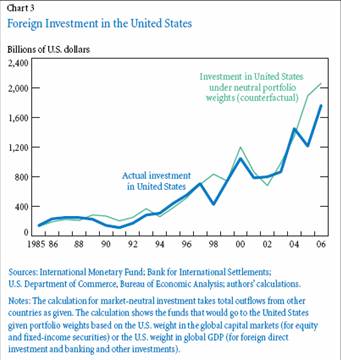Matthew Higgins and Thomas Klitgaard at the Federal Reserve Bank of New York discuss the outlook for financing the deficit, going forward, in a new Current Issues. From the introduction:
To finance its large current account deficit, the
United States must attract the equivalent
amount of surplus foreign savings. In recent
years, the U.S. deficit has been large enough to absorb the
lion’s share of surpluses generated abroad. Indeed, from
1999 through 2006, the cumulative U.S. borrowing of $4.4
trillion amounted to some 85 percent of the net external
financing provided by countries with surplus saving.
Despite this heavy borrowing, however, the United
States has been the destination for little more than 30 percent
of total gross cross-border investments by other countries,
a figure that only slightly exceeds the U.S. share of
global GDP and is below the U.S. weight in global financial
portfolios. As a result, the United States has been able to
finance its large current account deficits without laying
claim to a disproportionate share of global foreign investment
or causing foreign external portfolios to become
dominated by U.S. assets.
This edition of Current Issues sheds light on these seemingly
incompatible developments by examining the
financing of the U.S. current account deficit from a global
perspective. We find that the recent period of large U.S.
current account deficits has also been one of rapid financial
globalization, with surplus and deficit countries alike
investing a record fraction of their saving abroad. This
sharp increase in cross-border investments has made it
possible for the United States to emerge as the world’s
principal net borrower while receiving an unremarkable
share of other countries’ gross external investments.
Facilitating this development is the fact that the rise in U.S.
cross-border investment has lagged the rise in global
investment by other countries.
These findings have important implications for the sustainability
of the U.S. current account deficit. In our view,
it might be harder to finance continued large current
account deficits on favorable terms if the recent wave of
financial globalization were to subside: The United States
would then have to attract a larger share of other countries’
foreign investments. It might also be harder to finance the
deficit on favorable terms were U.S. investors to participate
more fully in financial globalization by investing a larger
fraction of domestic saving abroad.
The key difference between some other approaches to viewing sustainability, and theirs (which is well grounded in the finance literature), is in their focus on the shares of total world assets.
Alternative Metrics
Our analysis of foreign portfolio exposure to the United
States is based on investment in the country as a fraction of
global cross-border investments. In our view, this approach
illustrates underlying trends while controlling for the ongoing
progress of financial globalization. Still, a look at how
exposure to the United States has evolved relative to global
saving and global wealth might shed additional light on the
sustainability of the U.S. current account deficit.
Since 2002, investment in the United States has absorbed
16.5 percent of the rest of the world’s saving, up from 14.3
percent during 1997-2001 and up substantially from 7.0 percent
during 1992-96. Is the recent figure high or low? If such
investment were sustained, assuming stable exchange rates
and similar asset price behavior in the United States and
abroad, claims on U.S. assets would trend toward 16.5 percent
of total foreign wealth. We cannot know the potential
limits on desired foreign exposure to the United States; the
limits depend, in part, on how far the recent wave of financial
globalization can progress. That said, a 16.5 percent figure
would not be out of line with the U.S. weight in the global
economy and the global financial markets.
To highlight this point, consider the actual amount of investment in the U.S., compared to that predicted using their calculations.

Source: Higgins and Klitgaard (2008).
In other words, by looking at shares of assets, it doesn’t look like the stock of foreign investment in the US is out of line (keeping in mind substantive measurement issues, raised by the authors).
I particularly appreciated the nuanced view in which the authors conclude.
… Our results suggest that such globalization has
allowed the United States to finance large current account
deficits without experiencing sharper downward pressures
on the dollar and U.S. asset prices. However, a retreat from the recent pace of financial globalization by foreign investors
or an increase in the rate at which U.S. investors buy foreign
assets could make it more difficult for the country to sustain
a large current account deficit on favorable terms.
I think that this is a particularly salient point. The net inflows to the US over the past decade can be viewed in part as a stock-flow adjustment process. But the target “stock” might change as the attractiveness of US assets declines (think sub-prime and soon Alt-A’s, CDOs, and soon CDSs, etc.). At that point, the stock-flow perspective could look a lot like a “disorderly adjustment” in the flow perspective.
Technorati Tags: current account,
financial globalization,
net international investment position.
Professor Chinn, once again, thanks for highlighting and elucidating interesting research.